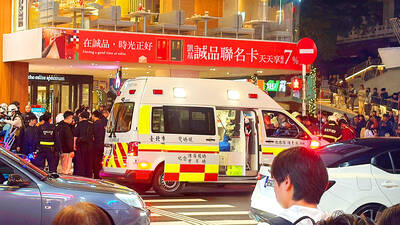Export orders fell 3.04 percent last month from a year earlier to US$36.47 billion, marking the third consecutive month of single-digit year-on-year decline because of continuous weak demand, the Ministry of Economic Affairs said yesterday.
By country, export orders from China — the nation’s largest export destination — declined 4.32 percent year-on-year last month to US$9.42 billion, with precision instruments accounting for the biggest decline.
“The decrease [in orders] marked the sixth consecutive year-on-year decline and reflected China’s economy remaining in a conundrum,” Beatrice Tsai (蔡美娜), deputy director of the ministry’s Department of Statistics, told a press conference.
Export orders from the US grew 5.86 percent year-on-year to US$8.75 billion last month, with electronic products contributing most to the increase, topping the same month last year by US$240 million, the ministry’s data showed.
“The US was the only region among the six major export regions from which Taiwan received year-on-year export growth in May, indicating better momentum in the US economy and stronger private consumption in the country,” Tsai said.
Orders from Europe fell 8.17 percent annually to US$6.33 billion, with transportation goods accounting for the most contraction, the data showed.
Six ASEAN countries (Singapore, Malaysia, Indonesia, Philippines, Thailand and Vietnam) placed US$3.88 billion in orders with Taiwan — a decline of 8.16 percent from last year, data showed.
It marked the first decline for the six ASEAN nations since the financial crisis of 2008, Tsai said.
Last month’s export orders from Japan declined for the 13th consecutive month since May last year, but last month was the smallest decline recorded, indicating that Japan was recovering from the earthquake and tsunami in March last year, Tsai said.
By product, information technology and electronics goods accounted for the greatest number of orders with totals of US$9 billion and US$8.52 billion respectively. The US and China were the two largest importers of those goods, the ministry said.
On a monthly basis, export orders rose 1.07 percent from the US$36.09 billion reported in April, the data showed.
Orders in the first five months contracted US$970 million, or 0.55 percent, to US$176.37 billion from a year ago, the data showed.
This month, export orders are expected to dip year-on-year from the US$37.36 billion recorded a year ago, the ministry said.
Those figures should improve slightly from last month given that a ministry sentiment index stood at 55.59, which was above the base of 50, Tsai said.
Looking ahead, some beneficial factors, such as events like Computex and Apple’s Worldwide Developers Conference, would drive up export orders for handheld devices and notebook PCs, Tsai said.
China’s lowering of interest rates to stimulate domestic consumption would also help export orders.
However, the debt crisis in the eurozone, the slowing global economy, declining demand for plastic, chemical and basic metal raw materials and the approach of the traditional weak season for electronic industries would negatively affect the export order outlook in the near future, Tsai said.

TRAGEDY STRIKES TAIPEI: The suspect died after falling off a building after he threw smoke grenades into Taipei Main Station and went on a killing spree in Zhongshan A 27-year-old suspect allegedly threw smoke grenades in Taipei Main Station and then proceeded to Zhongshan MRT Station in a random killing spree that resulted in the death of the suspect and two other civilians, and seven injured, including one in critical condition, as of press time last night. The suspect, identified as a man surnamed Chang Wen (張文), allegedly began the attack at Taipei Main Station, the Taipei Fire Department said, adding that it received a report at 5:24pm that smoke grenades had been thrown in the station. One man in his 50s was rushed to hospital after a cardiac arrest

A car bomb killed a senior Russian general in southern Moscow yesterday morning, the latest high-profile army figure to be blown up in a blast that came just hours after Russian and Ukrainian delegates held separate talks in Miami on a plan to end the war. Kyiv has not commented on the incident, but Russian investigators said they were probing whether the blast was “linked” to “Ukrainian special forces.” The attack was similar to other assassinations of generals and pro-war figures that have either been claimed, or are widely believed to have been orchestrated, by Ukraine. Russian Lieutenant General Fanil Sarvarov, 56, head

SAFETY FIRST: Double the number of police were deployed at the Taipei Marathon, while other cities released plans to bolster public event safety Authorities across Taiwan have stepped up security measures ahead of Christmas and New Year events, following a knife and smoke bomb attack in Taipei on Friday that left four people dead and 11 injured. In a bid to prevent potential copycat incidents, police deployments have been expanded for large gatherings, transport hubs, and other crowded public spaces, according to official statements from police and city authorities. Taipei Mayor Chiang Wan-an (蔣萬安) said the city has “comprehensively raised security readiness” in crowded areas, increased police deployments with armed officers, and intensified patrols during weekends and nighttime hours. For large-scale events, security checkpoints and explosives

PUBLIC SAFETY: The premier said that security would be tightened in transport hubs, while President Lai commended the public for their bravery The government is to deploy more police, including rapid response units, in crowded public areas to ensure a swift response to any threats, President William Lai (賴清德) said yesterday after a knife attack killed three people and injured 11 in Taipei the previous day. Lai made the remarks following a briefing by the National Police Agency on the progress of the investigation, saying that the attack underscored the importance of cooperation in public security between the central and local governments. The attack unfolded in the early evening on Friday around Taipei Main Station’s M7 exit and later near the Taipei MRT’s Zhongshan